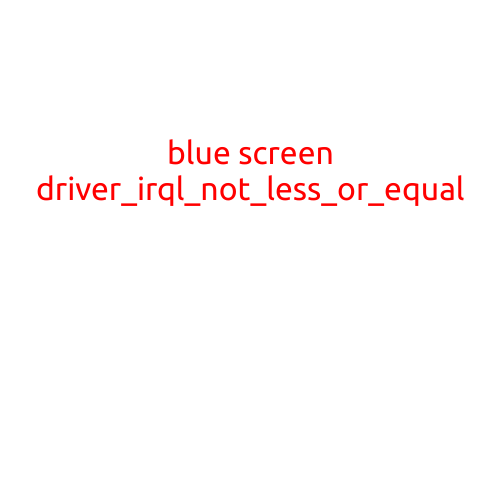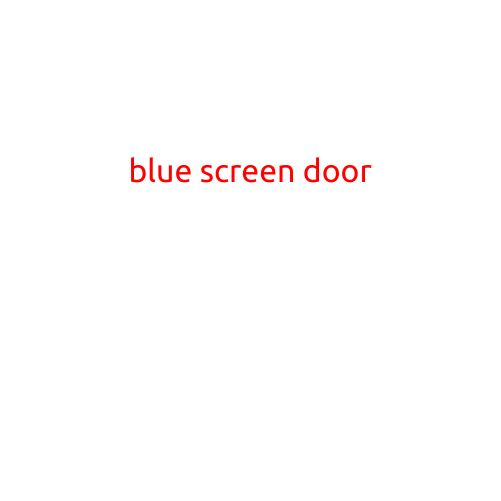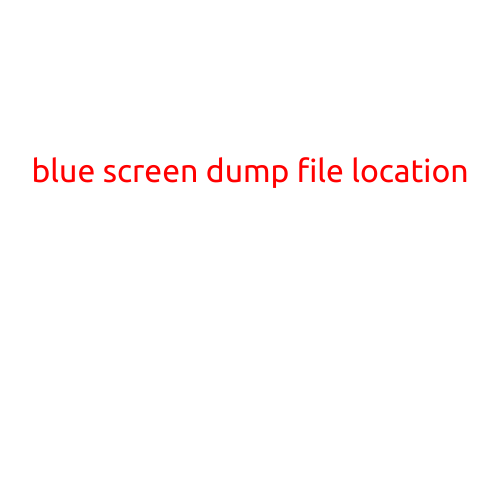
Blue Screen of Death: Driver_IRQL_NOT_LESS_OR_EQUAL (0x0000000A)
The Blue Screen of Death (BSoD) is a familiar sight for many Windows users, and it can be a frustrating and confusing experience. One of the most common BSoD errors is the “Driver_IRQL_NOT_LESS_OR_EQUAL” error, which is identified by the error code 0x0000000A. In this article, we’ll dive into the causes, symptoms, and solutions to help you resolve this annoying issue.
Symptoms
When you encounter the “Driver_IRQL_NOT_LESS_OR_EQUAL” error, you’ll see a blue screen with the following message:
DRIVER_IRQL_NOT_LESS_OR_EQUAL
(0x0000000A)
A suspected driver problem or system failure has caused the system to shut down. This may be due to a driver's IRQL is not less than or equal to the device driver's requested IRQL. This may be due to a driver's IRQL is not less than or equal to the device driver's requested IRQL. If this keeps happening shutdowns will occur.
The system will then automatically restart, and you may hear a series of beeps as Windows tries to troubleshoot the issue.
Causes
The “Driver_IRQL_NOT_LESS_OR_EQUAL” error occurs when a device driver attempts to access memory at an IRQL (Interrupt Request Level) that is higher than the current IRQL of the system. This can happen due to several reasons, including:
- Driver conflicts: When two or more device drivers clash, it can cause this error.
- Corrupted drivers: A corrupted or outdated driver can cause the BSoD.
- Hardware issues: Faulty or malfunctioning hardware components can trigger this error.
- System file corruption: Corruption of system files or registry entries can also cause the BSoD.
Solutions
To resolve the “Driver_IRQL_NOT_LESS_OR_EQUAL” error, follow these steps:
- Restart your system: Sometimes, a simple system restart can resolve the issue.
- Check for driver updates: Go to the Device Manager, update driver software, and ensure all drivers are up-to-date.
- Disable driver updates: If a specific driver is causing the issue, try disabling it and then re-enabling it to see if the error occurs again.
- Run a System File Checker (SFC) scan: Run the SFC scan to check and repair corrupted system files.
- Run a DISM scan: Run the Deployment Image Servicing and Management (DISM) tool to scan and fix corrupted system files and registry entries.
- Check for malware: Run a full scan with your antivirus software to detect and remove any malware infections.
- Check for hardware issues: Run a hardware diagnostic test to identify and potentially fix any issues with your hardware components.
- Restore your system to a previous point: If you’ve made recent changes to your system, try restoring to a previous point when the error didn’t occur.
- Perform a clean install: If none of the above steps resolve the issue, you may need to perform a clean install of Windows or contact a professional for further assistance.
Prevention
To prevent the “Driver_IRQL_NOT_LESS_OR_EQUAL” error from occurring, follow these best practices:
- Regularly update your device drivers
- Keep your system and software up-to-date
- Avoid installing untrusted software or drivers
- Monitor system performance and troubleshoot errors promptly
- Back up your system regularly to prevent data loss
In conclusion, the “Driver_IRQL_NOT_LESS_OR_EQUAL” error is a common BSoD issue that can be caused by a variety of factors. By identifying the cause and following the necessary steps to resolve the issue, you can get back to using your Windows system without any interruptions. Remember to always practice good system maintenance and troubleshooting habits to prevent this error from occurring in the future.





